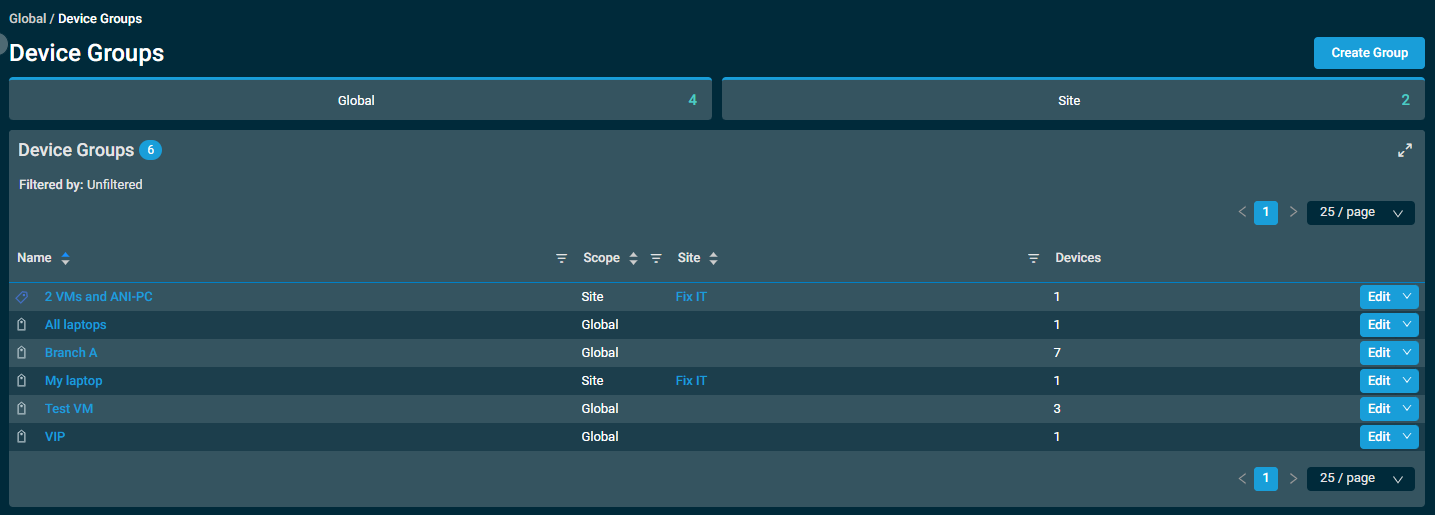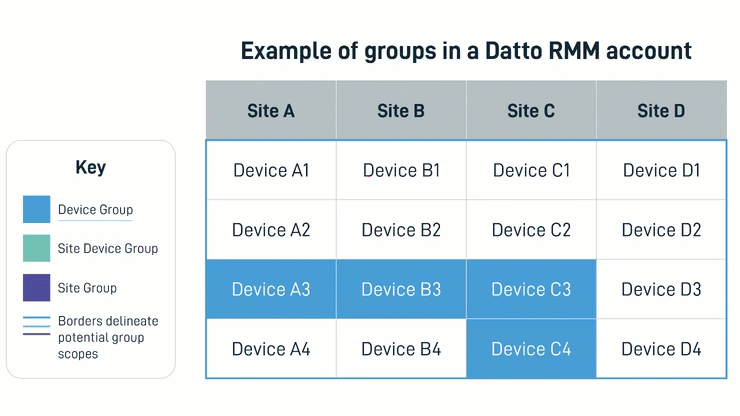Groups
PERMISSIONS Refer to Global > Groups and Sites > Groups in Permissions. Also refer to Device visibility.
NAVIGATION Filters and Groups > Groups
NAVIGATION Global > Groups
NAVIGATION Sites > All Sites > click the name of a site > Groups (left navigation menu)
NAVIGATION Devices > All > Filters & Groups > select Device Groups from the drop-down menu in the pane
NAVIGATION For Site Groups security and navigation paths, refer to Site Groups.
About groups
In Datto RMM, groups are used to group specific devices or sites in situations where you cannot or choose not to use filters. Devices can be grouped at both the global and the site level. Sites can be grouped at the global level. Groups can be used as the target for monitors, reports, and jobs.
Similarly to filters, groups work independently of sites. This means that you can group devices from many sites together. However, as opposed to filters, groups are static, which means that adding or removing devices or sites to or from groups is a manual activity that is carried out in the web interface.
Users with the Administrator security level can control which devices each security level has access to, which includes the option to include or exclude specific groups. For details, refer to Device visibility in Security levels.
The following GIF illustrates the scope of group types in Datto RMM and examples of how groups can be organized in an account:
Device Group
Device Groups contain devices grouped at the global level.
Site Device Group
Site Device Groups contain devices grouped at the site level.
Site Group
Site Groups contain sites grouped at the global level. Refer to Site Groups.
Creating a Device Group or Site Device Group
To create a group, follow any of the first three navigation paths described in Security and navigation and click Create Group.
To learn how to create a Site Group, refer to Creating a Site Group.
Enter a name for the group.
Select Global (default) to create a Device Group or Site to create a Site Device Group. Refer to Group types. If you are creating a Site Device Group from a site-level Device Groups page or from the device summary page, the site will be pre-populated.
If Site is selected, click Yes if you wish to add this group to other sites within your account (all future sites created will include this group). Click No to choose the target site. Enter the name of the site. The search results will be narrowed as you type.
NOTE In order to create a Site Device Group, the security level of the user initiating creation or editing the Site Device Group will need to have Manage access for both groups and devices at the site level. Refer to Security levels.
Select a color to easily identify this group in various places throughout the web interface. When selected, the color will appear to float higher than the other colors in the row. If no color is selected, the group will be saved with the default color (gray).
Devices can be added to the group individually. Click Add Device. From within the pane that opens, select Add next to each device you would like to add, or search for devices by hostname. The search results will be narrowed as you type. If you are creating a Site Device Group, devices will be limited to the specified site.
NOTE You can either add devices individually or upload them in bulk, but you cannot do both at the same time. Either delete an uploaded CSV file first in order to add devices individually, or save the group first before editing. Refer to Editing or deleting a Device Group.
NOTE The Bulk Upload option is only available for global Device Groups. Refer to Scope.
Devices can be added to the group in bulk by CSV file. The file should include a list of the devices identified by either UID (unique identifier of the device) or hostname. These values in the CSV file must exactly match these values in Datto RMM. You can export these values from any list of devices with the Hostame or UID field selected in the Column Chooser. Refer to List of devices and Export Selected Rows to CSV.
A column header is required. The header should be named some variation of uid or hostname but is not case sensitive.
Click Add CSV File and select the file to upload. A dialog box will confirm whether you wish to save this group with the uploaded devices. Click Save and then OK.
NOTE You can either add devices individually or upload them in bulk, but you cannot do both at the same time. Either remove the individually added devices first in order to upload in bulk with a CSV file, or save the group first before editing. Refer to Editing or deleting a Device Group.
When you are finished, click Save to create the group or Cancel to discard the new group progress and return to the Device Groups page.
NOTE The Name field is required for the Save button to become available. If Site is selected, you must also enter a site name.
A dialog box will confirm whether you wish to create this group. Click Confirm to execute the action or Cancel to close out of the dialog box. A confirmation dialog box will confirm that the group has been created successfully. If you created the group by clicking Create Device Group from the device summary page, you will be redirected back to the page, and the new group will be included in the Summary card.
Viewing and managing Device Groups and Site Device Groups
For Site Groups information, refer to Viewing and managing Site Groups.
Navigate to a Device Groups page by following any of the first three navigation paths described in Security and navigation.
Viewing Device Groups at global and site levels
From the left navigation menu, click either Global > Groups or Filters and Groups > Groups to see all Device Groups. At the top of the page, click Global to filter the list by devices grouped at the global level (known as Device Groups) or Site to filter the list by devices grouped at the site level (known as Site Device Groups).
To see a list of Site Device Groups of only one site, enter a site name in the Site column filter. Alternatively, from the left navigation menu, click Sites > All Sites > click the name of a site > Groups.
The table displays the following information:
| Field | Sortable? | Description |
|---|---|---|
| Name |
|
The name of the Device Group. Click the link to go to the list of the devices targeted by this Device Group. Refer to Viewing devices. To narrow the list, click the filter icon If a color has been configured for the group, the tag icon displays the color and appears rotated. If no color is configured, the default color is displayed and the tag icon does not appear rotated. Refer to Tag Color. |
| Scope |
|
In a global list of devices, displays the group scope, which can be one of the following:
To narrow the list, click the filter icon |
| Site |
|
In a global list of devices, displays the name of the site the devices are contained in. Click the link to go to the site's site summary page. Refer to Site summary. To search for a particular site, click the filter icon |
| Devices |
|
Displays the number of devices contained in the Device Group. |
The columns can be reordered and resized. The order and size of the columns will persist the next time the page is accessed.
You can filter any columns with the filter icon ![]() . The Filtered by bar displays all applied column filters. If a filter search term includes wildcard characters (for example, underscores and percent signs), they serve as normal characters if they are preceded by a backslash. For details, refer to Wildcard characters. Click the X next to any filter to remove that filter or click Reset Filters to remove all filters. If no filter is applied, the Filtered by bar displays Unfiltered. The filter selection will not persist the next time the page is accessed as the table will return to the default view (unfiltered).
. The Filtered by bar displays all applied column filters. If a filter search term includes wildcard characters (for example, underscores and percent signs), they serve as normal characters if they are preceded by a backslash. For details, refer to Wildcard characters. Click the X next to any filter to remove that filter or click Reset Filters to remove all filters. If no filter is applied, the Filtered by bar displays Unfiltered. The filter selection will not persist the next time the page is accessed as the table will return to the default view (unfiltered).
The table density is set to condensed theme by default. To change it to relaxed theme, click the density toggle icon. ![]() The selection will persist across all pages.
The selection will persist across all pages.
The number of results displayed can be specified by selecting the desired number from the pagination control. This selection will persist the next time the page is accessed.
Click the Device Group name in the Name column to open the list of the devices targeted by the Device Group.
NOTE If there are no matching devices, the list will be empty.
The table density is set to condensed theme by default. To change it to relaxed theme, click the density toggle icon. ![]() The selection will persist across all pages.
The selection will persist across all pages.
The refresh icon ![]() allows you to reload the data while keeping existing filters when already configured.
allows you to reload the data while keeping existing filters when already configured.
NOTE Column filtering is not available in this table.
The Column Chooser icon ![]() allows you to select which columns should be visible in the list. Refer to Column Chooser field definitions for descriptions of all of the available fields.
allows you to select which columns should be visible in the list. Refer to Column Chooser field definitions for descriptions of all of the available fields.
The number of results displayed can be specified by selecting the desired number from the pagination control. This selection will persist the next time the page is accessed.
Refer to Action buttons in Devices for more information about the actions available from within this table.
Device Groups can be modified from the table. You can edit a group in the following ways:
- To update Device Group details, click Edit in the last column in the table. Refer to Creating a Device Group or Site Device Group.
NOTE The scope of the group (Global or Site) and the associated Site are not editable.
NOTE Bulk uploading devices to an existing group will add those devices to the existing devices in the group. Click Save and then OK to confirm. The Bulk Upload option is only available for global Device Groups. Refer to Scope.
NOTE Adding or removing devices from Device Groups with more than 500 devices must be done from within the Devices table. Refer to Action buttons.
-
To delete the Device Group, in the last column in the table, click the drop-down arrow next to Edit and click Delete. Note that anything currently associated will be affected.
In the confirmation dialog box that appears, select the I understand that this action is irreversible check box to confirm the action. Click Delete to execute the action or Cancel to close out of the dialog box.




